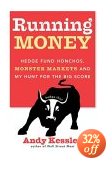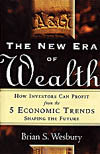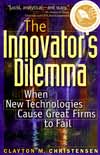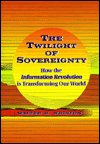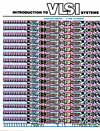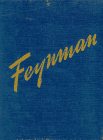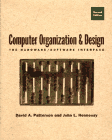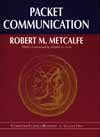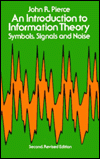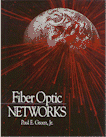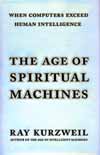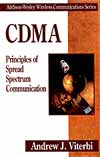Past Featured Books
Click on any book to order now at

The Qualcomm Equation
by David Mock, with Forward by George Gilder
Order Your Copy Today !
"The Qualcomm Equation by Dave Mock, is a probing account of the rise of the company and the development of its multifaceted strategies for dominance. Once a skeptic toward CDMA, Mock has become perhaps its ablest exponent. In this wide ranging and lucidly written book, he evokes the personalities, the interwoven innovations, the tumultuous history, the global strategy, and the intellectual property of what has become the exemplary Twenty-First Century Technology Company." — George GilderFeaturing a foreword by George Gilder The Qualcomm Equation provides readers with a fascinating inside look at how a small company stormed the burgeoning wireless industry and grew into a global multibillion-dollar powerhouse in less than a decade. This book examines how Qualcomm became so successful, chronicling the early history of the company, then provides an in-depth analysis of Qualcomm's business model. Through this eye-opening, real-life case study, readers will learn: how the company pioneered and commercialized a new technology in record time...and made it an industry standard; how Qualcomm's revolutionary business model relied on licensing this technology; key business strategies that enabled Qualcomm to leapfrog the competition; how companies can encourage and use innovation to dominate their markets. In addition to describing the development of the wireless industry over the last few decades, The Qualcomm Equation is a riveting look at a one-of-a-kind company.
The Bottomless Well:
The Twilight of Fuel, the Virtue of Waste, and Why We Will Never Run Out of Energy
by Peter W. Huber, Mark P. Mills
Order Your Copy Today !
A myth-shattering book that explains why energy is not scarce, why the price of energy doesn't matter very much, and why "waste" of energy is both necessary and desirable.
The sheer volume of talk about energy, energy prices, and energy policy on both sides of the political aisle suggests that we must know something about these subjects. But according to Peter W. Huber and Mark P. Mills, the things we think we know are mostly myths. In The Bottomless Well, Huber and Mills show how a better understanding of energy will radically change our views and policies on a number of very controversial issues.
Writing in take-no-prisoners, urgently compelling prose, Huber and Mills explain why demand for energy will never go down, why most of what we think of as "energy waste" actually benefits us; why more efficient cars, engines, and bulbs will never lower demand, and why energy supply is infinite.
Soft Machines: nanotechnology & life
by Richard A.L. Jones
Order Your Copy Today !
Having spent much of my time since the Gilder/Forbes Telecosm Conference (October 19 – 20, 2004) deep in books about nanotech, I can report that the field is real and that it has already yielded a definitive text. Entitled Soft Machines: nanotechnology & life, elegantly written by a UK physicist named Richard A.L. Jones, it arrives at the essential destination that Gilder Technology Report Editor, Nick Tredennick, defined three years ago at his Dynamic Silicon Conference.Nanotech is the result of the continuing advance of semiconductor technology into the nanoscale, where it can form devices the size of molecules and biological organelles. Thus semiconductors can drop below the electro-mechanical domain into the domains of bio-mimesis where designers take inspiration from biological structures. As Jones patiently shows, the effort to reduce biology and chemistry to physical mechanics, as Erik Drexler proposed, founders at the nanoscale. Here the environment is dominated by Brownian motion at up to 10 gigahertz, by low Reynolds numbers signifying extreme viscosity, and by surface effects such as Van der Waals forces that dwarf the bulk effects of conventional mechanics. Jones concludes that while nanotech has developed new materials such as semiconducting polymers, new test gear such as gold and thiols on silicon substrates, fabrication equipment such as atomic force microscopes, new devices such as rotaxanes, nanotube nanistors, and C60 fullerenes, it is far from creating integrated systems or transducers that link to or from its laboratory concoctions. One of the best science and technology texts I have ever read, this book is a tribute to the fertility of disciplinary intercourse among solid-state physics, chemistry and biology.
Also worth reading is Nanocosm by William Ilsey Atkinson, a breezy but useful journalistic tour of the nanotech scene, which contains a cogent argument against the Drexlerian movement and presents intriguing portraits of such nanotech leaders as Thomas Theis of IBM and an array of fascinating Japanese scholars. The Scientific American book, Understanding Nanotechnology, published in 2002, adapts a series of articles from the magazine, including a notable foreword and early chapter from exemplary Caltech teacher Michael Roukes.
— George Gilder
After spending much of my holiday reading time with estimable critics of the Telecosm such as Om Malik (Broadbandits) and David Denby (American Sucker), I innocently picked up a book called The Long Walk by Slavomir Rawicz, defying the most urgent warnings from historian Stephen Ambrose that I would not be able to put it down. Sure enough, the darn book adhered to my hands for the next two days-in the bathtub, under the Christmas tree, at lunch, and in the car to cross-country ski races-and I emerged from my ordeal with an inspiring new perspective on all the trials of this Millennium. Incarcerated in a concentration camp in north eastern Siberia, Rawicz and six colleagues escaped during a blizzard, and most of them managed to elude dogs, KGB, apparently abominable snowmen, and marauding Chinese soldiers, and make their way nearly 4000 miles in 18 months through the Siberian snows and the Gobi desert and through Mongolia and Tibet and over the Himalayas to India. Full of fascinating details of survival against all odds both in the desert and the mountains, in sub zero and trans-100 Farenheits. Perhaps there is still hope for the all optical revelation.
Running Money
by Andy Kessler
Order Your Copy Today !
George Gilder's latest pick for "Book of the Month" is Andy Kessler's memoir Running Money. A brilliant investor, a born raconteur and an overall smart-ass, Andy Kessler pulls back the curtain on the world of hedge funds and shows how the guys who run big money think, talk and act.Following on the success of Wall Street Meat, his self-published book on the lives of Wall Street stock analysts, Andy Kessler recounts his years as an extraordinarily successful hedge fund manager. To run a successful hedge fund you must have an investing edge -- that special insight that allows you to reap greater returns for your clients and yourself.
A quick study, Kessler gets an education in investing from some fascinating and quirky personalities. Eventually he works out his own insight into the world economy, a powerful lens that reveals to him hidden value in seemingly negative trends. Focusing on margin surplus, Kessler comes to see that current American economy, at the apex of the information revolution, is not so different from the British economy at the height of the industrial revolution. Drawing out the parallels he develops a powerful investing tool which he shares with readers. Contrarian and confident, Kessler made a fortune applying his ideas to his hedge fund. Which only proves that they may not be as crazy as they sound.
"(One of) the best books you'll find on technology, opportunity and entrepreneurship [to] hit bookstores."
-Rich Karlgaard, Publisher, Forbes magazine
Life 2.0 : How People Across America
Are Transforming Their Lives by Finding
the Where of Their Happiness
by Rich Karlgaard
Order Your Copy Today !
Written with literary flair and analyzed with rare social and financial insight, Life 2.0 combines a gifted novelist's sense of personal drama and pace with a technology visionary's insight into the future. Take an epochal ride in Rich Karlgaard's aerobatic new book. Not only will it stretch your mind and wide the horizons of your life, it also could renew your health and wealth. — George Gilder
Heavenly Intrigue
by Anne-Lee Gilder and Joshua Gilder
Order Your Copy Today !AVENGING MACHINES
Some ten years ago, after a hard run over a steep hill in my home town, my cousin Joshua Gilder challenged me to explain the prevalence of inverse square laws in science. Joining Newton's Law of Gravitation with Coulomb's law of electromagnetic attraction, inverse square laws inform the physics of attraction, whether of magnitudes or magnetism. Grasping at straws, I mumbled something about the quadratic expansion of areas and diminution of forces as any influence spreads out from a point after a Big Bang blah blah blah. But my mumbling did not satisfy Josh's raptorial mind.Together with his wife Anne-Lee, an investigative reporter and translator, Josh returns to the subject in our book of the month, Heavenly Intrigue: Johannes Kepler, Tycho Brahe, and the Murder behind one of History's Greatest Scientific Discoveries. Behind Kepler's famous finding that planetary orbits are ellipses, not perfect circles, is the implicit recognition of inverse squares of attraction. Behind this epochal discovery, Josh and his wife Anne-Lee have inferred from previously lost and untranslated documents and from spectrographic analysis of poisoned strands of Brahe's hair found in his tomb, was a murder. They conclude it was probably committed by Kepler, determined to seize Brahe's huge trove of astronomical observations, crucial to Kepler's own more astrological researches.
Heavenly Intrigue stands as a superb exploration of the contentious relations between science and technology. A lifelong astrologer, Kepler emerges as a precursor of the politically correct abstract scientist of today musing on global warming in multiple parallel universes in the pages of Scientific American and imposing his own predilections for form and fashion on the intractable stuff of the world. Brahe is a creator of the exquisitely accurate and advanced technology that measured the paths of the stars to one part in 253 thousand and rescued astronomy from the astrological pseudo science of the day. "With Brahe's measurements as the standard," observe the Gilders, "the wheels of astronomy would grind exceedingly fine."
Best known as the author of some of Ronald Reagan's most memorable utterances, from his blunt veto threat to a tax hiking Congress-"Go ahead, make my day"-to his eloquent celebration of capitalism and technology at Moscow State University, Josh has become an accomplished writer of fiction. Last year his Ghost Image won laurels for a first mystery novel. This book combines the punctilious lucidity of his expository style with the narrative intrigue of a murder story.
As intricately layered as a microchip, as compellingly plotted as a Columbo mystery, as scrupulously factual as its hero Brahe himself, Heavenly Intrigue launches a new form of literature: history of science and technology as philosophical adventure and psychological thriller. In a beautiful consummation, the seeds of Brahe's rigorous empirical science ultimately give birth in the late twentieth century to new machines, such as atomic absorption spectrometers and proton induced x-rays, that enable current day sleuths to discover and solve his murder. In this book, the Gilders illuminate this twisted path of science and technology, avenge the crime, and redeem it. Now they should proceed with the screenplay, perhaps to be directed by Anthony Mingella and titled The Talented Mr. Kepler.
— George Gilder
The Long Walk
by Slavomir Rawicz
Order Your Copy Today !
— George Gilder
The Innovator's Solution: Creating and Sustaining Successful Growth
by Clayton M. Christensen, Michael E. Raynor
Order Your Copy
Towering over his colleagues in business analysis, Clayton Christensen has proven that he is not just another tall white guy who hangs around the basket and piles up the easy points.After introducing a champion product at the top of his game six years ago, garnering huge markets, magisterial prestige, devoted students, and a double chair at the Harvard Business School, Christensen triumphantly flouts his own chilling odds against renewing a stalled franchise. Written with colleague Michael Raynor, his second book is a whopper of a further innovation: The Innovator's Solution: Creating and Sustaining Successful Growth, even more gripping and compelling than his first work. His famous core concept of disruptive innovation, launched in his now classic prize winner The Innovator's Dilemma, has begotten a scintillating sequel, full of powerful business ideas that continue spinning in the mind long after you put down the book.
Using an insight of my partner Nick Tredennick, I would like to sum up Christensen's initial theory as a form of Tredennick's law: "Seek performance first and you forgo volume. Seek volume first and you get performance."
Catchy isn't it? The essence of it is the learning curve. Creating a high performance product is only the first step. If you make one brilliant prototype of a magical Silicon Wonderchip XXX, and then embark on an agenda of costly performance improvements, you will restrict yourself to a sparse population of elite users. In the end, this small market of demanding buyers-whether of high-end cameras or high-end routers or specialized business communications-will not be able to pay for the early rate of improvement. Meanwhile your rival-Intel, perhaps-incorporates an inferior ripoff on some underused corner of a Pentium and makes billions of units. Moving down the learning curve of the semiconductor industry with Moore's law, the Pentium will soon be doing the job more cheaply and better than your Silicon WonderchipXXX."
Now in The Innovator's Solution, Christensen offers a broader, more far reaching, but less quantitative, discourse on business strategy. He tells executives why "core competence" shouldn't necessarily be your core business; when to outsource and when not; how to avoid the grim reaper of business-"commoditization"; how to develop products by asking the question "What job needs to get done?"; why large mergers almost never work; and how to counter disruptive threats-and even become the disrupter yourself-by forming autonomous organizations.
Christensen is full of sagely contrarian advice: he argues that it is usually better to give a new project to an executive who has previously failed at a similar undertaking, rather than one who has been highly successful in an unrelated field. The learning curve, in other words, applies to management not just manufacturing. He also shows how, depending on the circumstances, technologies can be disruptive for some firms but sustaining for others. The Internet, for example, sustained Dell's low-cost direct-to-customer marketing and distribution model but disrupted the retail models of Compaq, HP, IBM, and others.
Perhaps most importantly, Christensen and Raynor demolish the myth that young companies should be impatient for growth and patient for profits. Just the opposite, they argue. Demands for early profitability are good because they force new companies to adjust their business models based on feedback, rather than assuming the model is perfect from the outset, only to find out years later that the initial business plan was fatally flawed.
Christensen and Raynor's chapter endnotes-substantial, pithy, provocative-add further relish to a feast of business ideas.
— George Gilder & Bret Swanson
Wall Street Meat
by Andy Kessler
Order Your Copy
Our old friend and Telecosm star Andy Kessler has minced and marketed WALL STREET MEAT, the most riotous, insightful, poignant, gossipy, and gallivanting book on Wall Street ever written. Unlike the telepathic Michael Lewis, whose Liar's Poker was mostly written at three removes from the major players of the 1980s, Kessler was embedded big time, for both the eighties and nineties and he is still prescient in the new era. No fly or flower on the wall, Kessler was a major player on the field, a double-E from Bell Labs who actually grasped the intricacies of the technologies that he analyzed and they touted. He often told these Wall Street stars the score, or bit a bruised tongue dumbstruck when they did their daffy dunderheaded thing anyway. Then he went off and formed a hedge fund with Fred Kittler and scored on his own.
He was there as Bill Gates cackled at the credulity of analysts rushing to the phones to report a calculated putdown of his own stock; Kessler was at Jack Grubman's side as he honed his ax, his "A," his Ebbers and his AWE-strike, boasting three fictitious women per night, ten beers and four uncanny earning calls. Kessler was there, carrying true believer Mary Meeker's sachel as she rushed to her limo to tout her famous "feelings" about clueless.com to clueless dotty investors; he had frank conversations with Quattrone about the "monkeys in suits" that end up as brokers, and he did analytical hanky panky side by side with Blodget.But unlike most of the inebriated cast of this rollicking tale, Kessler never lost his head or sense of proportion. He got out on top, with his humor, writing flair, integrity, and portfolio intact. And he is about to get even richer on this self-published book, which has already leapt high at Amazon, where it tops the list at Morgan Stanley and Lehman Bros, is number 19 in New York and is moving up everywhere else.
This book may have begun in the boutique insider cult trade but it will be a bulge bracket paperback soon and then--I have a heart-felt feeling here, a Meeker moment--it will be a major motion picture. Read it before Kessler goes Hollywood and becomes too famous to talk to you anymore.
— George Gilder
Valuing Technology
The New Science of Wealth in the Knowledge Economy
by Chris Westland
Order Your Copy
In this ambitious and original text, Chris Westland follows in the path of Aswath Damodaran, casting light on "The Dark Side of Valuation" of technology stocks. But where Damodaran stops short of addressing the fundamental issues of technology itself, the polymathic Westland—a scientist and
consultant—cruises in with observations on Moore's and Metcalfe's laws, nanotechnology and optics, biotech and materials science. He attempts to formalize in crisp mathematics some of the "laws" of the microcosm and telecosm.
A fascinating read that does not pretend there are any simple answers or panaceas.
— George Gilder
The Advent of the Algorithm
by David Berlinski
Order Your Copy
Don't be put off by the author's vagaries and discursions. They are sometimes poetic and funny, sometimes distracting, but if you press on, you will encounter a unique tale of the real meaning of the science and technology of the twentieth century-the overthrow of the materialist superstition in the heart of mathematics physics, biology, and computer science. Berlinski was a student of Alonzo Church, who was the most fruitful protégé of Kurt Godel, who defined the limits of mathematics and tutored Einstein. This contrarian tour de force is a gripping adventure in the ideas that matter in the 21st century as it transcends and surpasses the 20th.
— George Gilder
Mind at Light Speed
by David D. Nolte
Order Your Copy
A leading physicist, solid state theorist, and inventor of dynamic holography, Nolte has reshaped telecosmic theory for the 21st century. Describing the promise of an all optical Internet and the limitations of human vision, he envisages a new computing and networking architecture based on the massive parallelism of holograms. With Avanex and Terabeam both gaining competitive advantage through holographic techniques, with Essex pursuing the huge advantages of analog optical processing, and with Carver Mead transforming the camera in the image of the human retina, Noltešs book is a paradigm tour. Lucidly written for the layman, it explores the parallel advantages of light and image in the new era of optics. He ends with an intriguing discussion of quantum computing.
In the Beginning Was the Command Line
by Neal Stephenson
Order Your Copy
In the Beginning Was the Command Line-is a fast, funny, and uncannily perceptive history of computer operating systems by the incomparable Neal Stephenson, author of Cryptonomicon, a panoramic historical novel which was one of the first and best of our books of the month. A former programmer, Stephenson explains in savvy and acrobatic prose the contribution of Microsoft and its obsolescence today, and explains why Linux is real—why operating systems will all be essentially free and open sourced.
Machine Beauty
by David Gelernter
Order Your Copy
Machine Beauty by David Gelernter explains and expounds the assumptions behind his transfiguration of the user interface through his company Mirror Worlds, named after his prophetic book by the same title, which essentially outlined the key features of the ultimate World Wide Web (still under construction today). Gelernter is an essential guide to the future of computer interfaces and databases.
The Quantum Brain
by Jeffrey Satinover
The Search for Freedom and the Next Generation of Man
Order Your Copy
The Quantum Brain is an adventure in the science of ideas. It is the first book on the brain that combines a grasp of the physics of the microcosm and the technologies of artificial intelligence, neural networks, and self-organizing systems, with a recognition of the transcendant properties that define the mind and differentiate it from matter. Although the subject is inherently difficult and novel, Jeffrey Satinover is an inspired guide through the fertile areas of convergence among the pivotal sciences of the age. From such insights will emerge both new technologies and new philosophies and theologies for the Twenty First Century.
Basic Economics
A Citizen's Guide to the Economy
by Thomas Sowell
Order Your Copy
Thomas Sowell is widely known as a masterly writer on the intricacies of race and culture around the globe. His recent autobiography offers a fascinating vista into his amazing life battling the forces of political correctness on issues of race. But Sowell began as a superb economic theorist, bringing to light the foundational principles of supply side economics in Says Law ("Supply creates its own demand") and Knowledge and Decisions. Now he has summed up a lifetime of economic wisdom in this definitive text, Basic Economics: A Citizen's Guide to the Economy. He offers pithy and trenchant accounts of a wide range of issues, from the perversity of rent controls and the wastefulness of recycling to the irrelevance of sex and race in income data and the true role of government in economy.
Collective Electrodynamics
Quantum Foundations of Electromagnetism
by Carver A. Mead
Order Your Copy
The book of the month (and perhaps of the decade; time will tell) is Collective Electrodynamics by Carver Mead, written is his copious free time while launching a revolution in the camera business with the Foveon imager. Mead's climactic speech at Telecosm, ending with a prolonged standing ovation, focused less on Foveon's amazing new chip and its impact on cameras than on his new book and its promise of a revolution in the physics of the electromagnetic spectrum. Some mathematics afflicts about two-thirds of the chapters, but the rest are readable and riveting.
The Holy Grail of Data Storage Management
What Every Enterprise Needs to Know to Solve Its Data Deluge
by Jon William Toigo
Order Your Copy
An excellent primer on network storage-perhaps the only in depth, book length treatment of the subject. The book does, however, suffer from conventional thinking. In particular, Toigo buys into the flawed notion that the number one reason for SAN architectures is to save network bandwidth. Recommended as good background reading on enterprise storage.

Subscriber
Login
Please
enter your account number:
Special Offer!
Subscribe
to Gilder Technology Report today. Save $100 and
get a FREE subscription to Gilder's weekly electronic
newsletter, the Friday Letter, PLUS 4 FREE SPECIAL
REPORTS from George Gilder!
Just fill in the form below and click 'Continue'.
 [Subscribe
Now!] [The
Newsletter] [Conferences]
[Bookstore]
[Contact
Us] [Home]
[Subscribe
Now!] [The
Newsletter] [Conferences]
[Bookstore]
[Contact
Us] [Home]
Click here for FREE weekly updates: The Gilder Friday Letter
©2004 Gilder Technology Report, a joint publication of Gilder Publishing, LLC and Forbes, Inc



